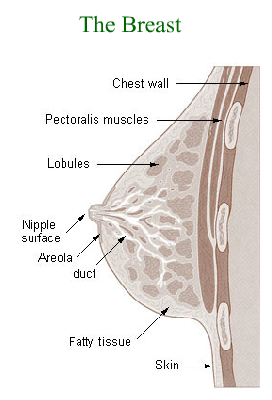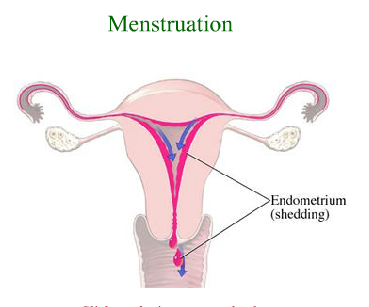
THE BREAST (ACCESSORY ORGAN OF REPRODUCTION)
The breasts are two mammary (milk-producing) glands located in the upper anterior region of the chest. The parts of the breast are as follows:
1. They are composed of glandular tissue that develop in response to hormones from the ovaries during puberty.
2. The breasts also contain fibrous and fatty tissue, special lactiferous (milk-carrying) ducts, and sinuses (cavities) that carry milk to the opening or nipple.
3. The breast nipple is called the mammary papilla, and the dark-pigmented area around the mammary papilla is called the areola. After parturition (giving birth), hormones from the pituitary gland stimulate the production of milk (lactation).

MENSTRUATION
The beginning of menstruation at the time of puberty is called menarche. Each menstrual cycle is divided into 28 days. These days can be grouped into 4 time periods, which describe the events of the cycle. The four time periods are:
1. Days 1-5 (Menstrual Period). These are the days during which bloody fluid containing disintegrated endometrial cells, glandular secretions, and blood cells is discharge through the vagina.
2. Days 6-12. After the menstrual period ends, the maturing graafian follicle secretes the hormone estrogen and the uterus begins to repair itself. This is also the period of the growth of the ovum in the graafian follicle.
3. Days 13-14 (Ovulatory Period). On about the 14th day of the cycle, the graafian follicle ruptures (ovulation) and the egg leaves the ovary to travel slowly down the uterin tube.
4. Days 15-28. The empty graafian follicle fills with a yellow material and becomes known as the corpus luteum. The corpus luteum functions as an endocrine organ and secretes two hormones, estrogen and progesterone, into the bloodstream. These hormones stimulate the building up of the lining of the uterus in anticipation of fertilization of the egg and pregnancy.
An ovum, after leaving the ovary, travels down a duct (fallopian tube0 leading to the uterus. If coitus (copulation, sexual intercourse) has occured, and sperm cells are present in the uterin tube, union of the ovum and sperm may take place. This union is called fertilization. If fertilization does not occur, the corpus luteum in the ovary stops producing progesterone and estrogen and regresses.
At this time, owing to the lowered levels of progesterone and estrogen, some women have symptoms of depression, breast tenderness, and irritability prior to menstruation. These symptoms are known as premenstrual syndrome (PMS). About 5 days after the fall in hormones, the uterine endometrium breaks down and the menstrual period begins (day 1-5).

 aziacademy1-Sangeetha
aziacademy1-Sangeetha